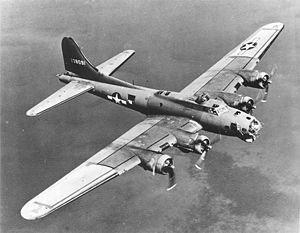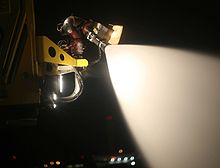- Deicing
-
For snow and ice control on roadways and similar facilities, see Snow removal
De-icing is defined as removal of snow, ice or frost from a surface. Anti-icing is understood to be the application of chemicals that not only de-ice, but remain on a surface and continue to delay the reformation of ice up to a certain period of time, or prevent adhesion of ice to make mechanical removal easier.
Contents
Methods
De-icing can be accomplished by mechanical methods (scraping, pushing); through the application of heat; by use of dry or liquid chemicals designed to lower the freezing point of water (various salts or brines, alcohols, glycols); or by a combination of these different techniques.
Anti-icing of aircraft is accomplished by applying a protective layer, using a viscous fluid called anti-ice fluid, over a surface to absorb the contaminate. All anti-ice fluids offer only limited protection, dependent upon frozen contaminant type and prevailing weather conditions. A fluid has failed when it no longer can absorb the contaminant and it essentially becomes a contaminant itself. Even water can be a contaminant in this sense, as it dilutes the anti-icing agent until it is no longer effective.
De-icing of roads has traditionally been done with salt, spread by snowplows or dump trucks designed to spread it, often mixed with sand and gravel, on slick roads. Sodium chloride (rock salt) is normally used, as it is inexpensive and readily available in large quantities. However, since salt water still freezes at -18°C or 0°F, it is of no help when the temperature falls below this point. It also has a strong tendency to cause corrosion, rusting the steel used in most vehicles and the rebar in concrete bridges. More recent snowmelters use other salts, such as calcium chloride and magnesium chloride, which not only depress the freezing point of water to a much lower temperature, but also produce an exothermic reaction. They are somewhat safer for concrete sidewalks, but excess should still be removed.
More recently, organic compounds have been developed that reduce the environmental issues connected with salts and have longer residual effects when spread on roadways, usually in conjunction with salt brines or solids. These compounds are generated as byproducts of agricultural operations such as sugar beet refining or the distillation process that produces ethanol.[1] Additionally, mixing common rock salt with some of the organic compounds and magnesium chloride results in spreadable materials that are both effective to much colder temperatures (-30°F/-34°C) as well as at lower overall rates of spreading per unit area.[2]
Direct infrared heating has also been proposed for deicing purpose. This heat transfer mechanism is substantially faster than conventional heat transfer modes used by conventional deicing (convection and conduction) due to the cooling effect of the air on the deicing fluid spray.
Environmental impact
Deicing salts such as sodium chloride or calcium chloride leach into urban soils, where they accumulate and can eventually become toxic to the organisms in these soils.[3]
Propylene glycol used to de-ice aircraft can contaminate drinking water supplies and harm aquatic life. Some airports are now capturing and treating de-icing runoff before allowing it to enter waterways.[4]
See also: Ice protection systemOn the ground, when there are freezing conditions and precipitation, de-icing an aircraft is crucial. Frozen contaminants cause critical control surfaces to be rough and uneven, disrupting smooth air flow and greatly degrading the ability of the wing to generate lift, and increasing drag. This situation can cause a crash. If large pieces of ice separate when the aircraft is in motion, they can be ingested in engines or hit propellers and cause catastrophic failure. Frozen contaminants can jam control surfaces, preventing them from moving properly. Because of this potentially severe consequence, de-icing is performed at airports where temperatures are likely to be around 0°C.
In flight, droplets of supercooled water often exist in stratiform and cumulus clouds. They form into ice when they are struck by the wings of passing airplanes and abruptly crystallize. This disrupts airflow over the wing, reducing lift, so aircraft that are expected to fly in such conditions are equipped with a de-icing system.
De-icing techniques are also employed to ensure that engine inlets and various sensors on the outside of the aircraft are clear of ice or snow.
De-icing on the ground is usually done by spraying aircraft with a de-icing fluid based on propylene glycol, similar to ethylene glycol antifreeze used in some automobile engine coolants. Ethylene Glycol (EG) is still in use for aircraft de-icing in some parts of the world because it has a lower operational use temperature (LOUT) than PG, but Propylene Glycol (PG) is more common because it is classified as non-toxic, unlike Ethylene Glycol. Nevertheless, it still must be used with a containment system to capture the used liquid, so that it cannot seep into the ground and water courses. Even though classified as non-toxic, it has negative effects in nature, since it uses oxygen during breakdown, causing aquatic life to suffocate. In one case, a significant snow in Atlanta in early January 2002 caused an overflow of such a system, briefly contaminating the Flint River downstream of the Atlanta airport. Many airports recycle used de-icing fluid, separating water and solid contaminants, enabling reuse of the fluid in other applications.
Fluid types
There are several types of de-icing fluid, falling into two basic categories: 1. De-icing fluids -Heated glycol diluted with water for de-icing and snow/frost removal, also referred to as Newtonian fluids (owing to their viscous flow similar to water) and 2. Anti-icing fluid - unheated, undiluted propylene glycol based fluids that has been thickened (imagine half-set gelatin), also referred to as Non-Newtonian fluids (owing to their characteristic viscous flow), applied to retard the future development of ice or to prevent falling snow or sleet from accumulating. Anti-icing fluids provide holdover protection against the formation of ice while the aircraft is stationary on the ground but when subjected to shearing force such as the air flow over the fluid surface, an aircraft accelerating for take off - the fuids whole reology changes and it becomes significantly thinner, running off to leave a clean and smooth aerodynamic surface to the wing. In some cases both types of fluid are applied, first the heated glycol/water mixture to remove contaminants, followed by the unheated thickened fluid to keep ice from reforming before the aircraft takes off. This is called "a two-step procedure".
Methanol de-ice fluid has been employed for years to de-ice small wing and tail surfaces of small to medium-sized general aviation aircraft and are usually applied with a small hand-held sprayer. Methanol can only remove frost and light ground ice prior to flight.
Mono-ethylene, di-ethylene and propylene glycol are nonflammable petroleum products and similar products are most commonly found in automotive cooling systems. Gylcol has very good de-icing properties and the aviation grade is referred to as SAE/ISO/AEA Type I (AMS 1424 or ISO 11075). it is usually applied to contaminated surfaces diluted 50% with water at 95 degrees Fahrenheit using a cherry picker on a truck containing 1500 to 2000 US Gallons (5680 to 7570 L) for on-ramp or departure runway entry point application. Colour-dyed fluid is preferred as it can be confirmed easily by visual observation that an aircraft has received a de-ice. Run off Type I appears to turn slush a pink tinge hence the term pink snow. Otherwise, all Type I fluids are orange.
 B-17 Flying Fortress. The black strips on the leading edges of the tail, stabilizers and wing are deicing boots made of rubber.
B-17 Flying Fortress. The black strips on the leading edges of the tail, stabilizers and wing are deicing boots made of rubber.
Pneumatic Systems
Inflight ice buildups are most frequent on the leading edges of the wings, tail and engines (including the propellers or fan blades). Lower speed aircraft frequently use pneumatic deicing boots on the leading edges of wings and tail for inflight de-icing. The rubber coverings are periodically inflated, causing ice to crack and flake off. Once the system is activated by the pilot, the inflation/deflation cycle is automatically controlled. In the past, it was thought such systems can be defeated if they are inflated prematurely; that the pilot must allow a fairly thick layer of ice to form before inflating the boots. Recent research shows “bridging” does not occur with modern boots.[5]
Electric Systems
Some aircraft may also use electrically heated resistive elements embedded in a rubber sheet cemented to the leading edges of wings and tail surfaces, propeller leading edges, and helicopter rotor blade leading edges. This de-icing system was developed by United States Rubber Company in 1943. [6] Such systems usually operate continuously. When ice is detected, they first function as de-icing systems, then as anti-icing systems for continued flight in icing conditions. Some aircraft use chemical de-icing systems which pump antifreeze such as alcohol or propylene glycol through small holes in the wing surfaces and at the roots of propeller blades, melting the ice, and making the surface inhospitable to ice formation. A fourth system, developed by NASA, detects ice on the surface by sensing a change in resonance frequency. Once an electronic control module has determined that ice has formed, a large current spike is pumped into the transducers to generate a sharp mechanical shock, cracking the ice layer and causing it to be peeled off by the slipstream.
Air Bleed Systems
Many modern civil fixed-wing transport aircraft use anti-ice systems on the leading edge of wings, engine inlets and air data probes using warm air. This is bled from engines and is ducted into a cavity beneath the surface to be anti-iced. The warm air heats the surface up to a few degrees above zero, preventing ice from forming. The system may operate autonomously, switching on and off as the aircraft enters and leaves icing conditions.
See also
References
- ^ Better Roads- dead link pending resolution with Better Roads magazine
- ^ http://www.magicsalt.info/Magic%20Salt.htm
- ^ Cunningham M.A., Snyder E., Yonkin D., Ross M., Elsen T. (2008) Accumulation of deicing salts in soils in an urban environment. Urban Ecosystems.
- ^ Tom Gibson (September 2002). "Let the Bugs Do the Work". Progressive Engineer. http://www.progressiveengineer.com/pewebbackissues2002/PEWeb%2030%20Sep%2002-2/Albany.htm. Retrieved 21 February 2011.
- ^ aopa.org pdf file
- ^ "De-Icer for Airplane Propeller is Made of Electric Rubber" Popular Mechanics, December 1943
Categories:- Air safety
- Aviation risks
- Road transport
- Chemical processes
- Ice in transportation
- NASA technology spinoffs
Wikimedia Foundation. 2010.


